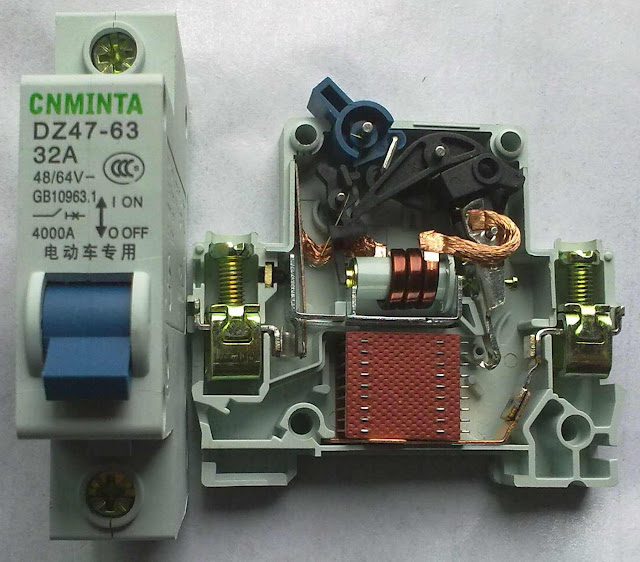Most mcbs are of single-pole construction for use in single-phase circuits. The complete working system is housed within a plastic moulding, typical external appearance being shown in Fig. (1). A section showing the principal parts of the mcb is shown in Fig. (2). The contact system comprises a fixed and a moving contact, and attached to each is a contact tip which provides a low-resilience contact junction to resist welding.
Fig (1) Miniature circuit breaker, external view
Fig (2) Principal parts of a miniature circuit breaker ABB
Modern mcbs are fitted with arc chutes consisting of metal plates which are held in position by insulating material. The arc chute does not necessarily surround the contact; in some designs arc runners are provided to pull the arc into the arc chute.
The tripping mechanism usually consists of a thermal-magnetic arrangement. The thermal action is provided by a bimetal with, in some cases, a heater. For ratings in the range 6–63A the bimetal forms part of the current path, the heat generated within the bimetal itself being sufficient to cause deflection. The deflection is then used to activate the tripping mechanism. The characteristics of the bimetal are chosen to provide particular delays under certain overload or fault currents according to the required time–current characteristic. A high-resistance bimetal is used for low-current devices and a lower resistance bimetal for high-current devices. In very low-current mcbs a heater may be incorporated around the bimetal in order to generate sufficient heat to deflect it.
High breaking capacity mini circuit breaker 32A
High breaking capacity mini circuit breaker 63A
The magnetic tripping element usually consists of a coil which is wrapped around a tube, there being a spring-loaded slug within the tube. Movement of the slug operates the tripping mechanism to open the mcb. It can also be used to assist in opening the contacts by locating the coil close to the moving contact.
When a fault current flows, the high magnetic field generated by the coil overcomes the spring force holding the slug in position; the slug then moves to actuate the tripping mechanism and forces the contacts apart by striking the moving contact arm. For low mcb ratings the coil is formed from thin wire with many turns; for higher ratings the wire is thicker, with fewer turns.
The magnetic trip is set by the manufacturer according to the required characteristics. These characteristics are defined in the standard and form ‘types’ which are shown in Table 1.
MCBs are designed and tested according to the requirements of IEC 898.
Table (1) Magnetic trip settings for mcbs





No comments:
Post a Comment